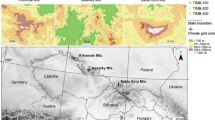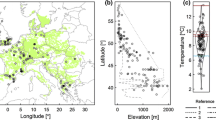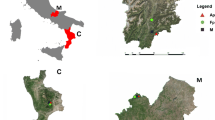Abstract
Key message
A global increase in temperature could potentially increase the trees’ growth at high altitude and decrease at low altitude. Another immediate consequence would be an increase of the altitude threshold where the inversion of tree growth response to temperature occurs.
Abstract
The first network of 18 tree-ring chronologies of Norway spruce (Picea abies) from the Eastern Carpathians (Romania) was studied in relation to the climatic factors and regional patterns in tree growth responses to climate. The sites are distributed along a latitudinal and altitudinal transect. The tree growth reaction to climate variability was analyzed by means of response functions. We used redundancy analysis (RDA) to identify regional patterns in the climatic response. The Norway spruce diameter growth patterns in Eastern Carpathians from Romania correspond to different climatic responses according to three elevation levels: low (≤1000 m a.s.l.); intermediate (1000–1300 m a.s.l.); high (≥1300 m a.s.l.). At high altitudinal level tree growth is strongly limited by summer temperatures. This climatic signal progressively decreases with decreasing altitude and increasing mean temperature. Tree growth at low elevation sites is controlled mainly by summer precipitations and in the intermediate elevation sites there is not any statistically significant correlation with climatic variables. At elevations of 1000–1100 m a.s.l., at a mean temperature of 13–13.5 °C in June and 15.5–16 °C in July, further increases in mean temperature result in an inversion of the relationship between tree-ring growth and temperature (i.e., the response becomes negative). A global increase in temperature could potentially increase the trees’ growth at high altitude and decrease at low altitude. Another immediate consequence would be an increase of the altitude threshold where the inversion of tree growth response to temperature occurs.







Similar content being viewed by others
References
Abrundan IV, Marinescu V, Ionescu O, Ioras F, Horodnic SA, Sestras R (2009) Developments in the Romanian forestry and its linkages with other sectors. Notulae Botanicae Horti Agrobotanici Cluj-Napoca 37(2):14–21
Andreassen K, Solberg S, Tveito OE, Lystad SL (2006) Regional differences in climatic responses of Norway spruce growth in Norway. For Ecol Manage 222:211–221
Barber VA, Juday GP, Finney BP (2000) Reduced growth of Alaskan white spruce in the twentieth century from temperature-induced drought stress. Nature 405:668–673
Barnes BV, Wagner WH (2004) Michigan Trees: a guide to the trees of the Great Lakes region. University of Michigan Press, Ann Arbor, p 439
Barry RG (1992) Mountain climatology and past and potential future climatic changes in mountain regions: a review. Mt Res Dev 12:71–86
Biondi F, Waikul K (2004) DENDROCLIM2002: a C++ program for statistical calibration of climate signals in tree-ring chronologies. Comput Geosci 30:303–311
Bonan GB, Shugart HH (1989) Environmental factors and ecological processes in boreal forests. Annu Rev Ecol Syst 20:1–28
Bouriaud O, Popa I (2007) Site and species influence on tree growth response to climate in Vrancea Mountains. Proc Rom Acad 9(1):63–72
Briffa KR, Jones PD (1990) Basic chronology statistics and assessment. In: Cook ER, Kairiukstis LA (eds) Methods of Dendrochronology: applications in the environmental sciences. International Institute for Applied Systems Analysis (IIASA). Kluwer Academic Publishers, Dordrecht, pp 137–152
Bunn AG, Waggoner LA, Graumlich LJ (2005) Topographic mediation of growth in high elevation foxtail pine (Pinus balfouriana Grev. et Balf.) forests on the Sierra Nevada. USA Glob Ecol Biogeogr 14:103–114
Buntgen U, Frank D, Schmidhalter M, Neuwirth B, Seifert M, Esper J (2006) Growth/climate response shift in a long subalpine spruce chronology. Trees 20:99–110
Büntgen U, Frank D, Wilson R, Carrer M, Urbinati C, Esper J (2008) Testing for tree-ring divergence in the European Alps. Glob Change Biol 14:2443–2453
Carrer M, Nola P, Eduard JL, Motta R, Urbinati C (2007) Regional variability of climate–growth relationships in Pinus cembra high elevation forests in the Alps. J Ecol 95:1072–1083
Cejkova A, Kolar T (2009) Extreme radial growth reaction of Norway spruce along an altitudinal gradient in the Sumava Mountains. Geochronometria 33:41–47
Churakova Sidorova OV, Eugster W, Zielis S, Cherubini P, Etzold S, Saurer M, Siegwolf R, Buchmann N (2014) Increasing relevance of spring temperatures for Norway spruce trees in Davos, Switzerland, after the 1950s. Trees 28:183–191
Cook ER, Kairiukstis LA (1990) Methods of dendrochronology. Applications in the environmental sciences. Kluwer Academic Publishers, Dordrecht, p 394
Cook ER, Krusic PJ (2006) ArstanWin 4.1.b_XP. http://www.ideo.columbia.edu
D’Arrigo RD, Kaufmann RK, Davi N, Jacoby GC, Laskowski C, Myneni RB, Cherubini P (2004) Thresholds for warming-induced growth decline at elevational tree line in the Yukon Territory Canada. Glob Biogeochem Cycle 18:GB3021. doi:10.1029/2004GB002249
Deslauriers A, Morin H, Urbinati C, Carrer M (2003) Daily weather responses of balsam fir (Abies balsamea (L.) Mill.) stem radius increment from dendrometer analysis in the boreal forests of Quebec (Canada). Trees 17:477–484
Dittmar C, Elling W (1999) Jahrringbreite von Fichte und Buche in Abhaengigkeit von Witterung und Hoehenlage. Forstwissenschaftliches Centralblatt 118:251–270
Donită I, Ivan D, Sanda V, Popescu A (1992) Romanian vegetation. Agricultural Technical Publishing, Bucharest 407 pp
Frank D, Esper J (2005) Temperature reconstructions and comparisons with instrumental data from a tree-ring network for the European Alps. Int J Climatol 25(11):1437–1454
Friedrichs DA, Buntgen U, Frank DC, Esper J, Neuwirth B, Loffler J (2009) Complex climate controls on 20th century oak growth in central-west Germany. Tree Physiol 29:39–51
Fritts HC (1976) Tree Rings and Climate. Academic Press, pp 567
Gaul D, Hertel D, Leuschner C (2008) Effects of experimental soil frost on the fine-root system of mature Norway spruce. J Plant Nutr Soil Sci 171:690–698
Grissino-Mayer HD (2001) Assessing crossdating accuracy: a manual and tutorial for the computer program COFECHA. Tree Ring Res 57:205–221
Häussling M, Jorns CA, Lehmbecker G, Hecht-Buchholz C, Marschner H (1988) Ion and water uptake in relation to root development in norway spruce (Picea abies (L.) Karst.). J Plant Physiol 133(4):486–491
Helle G, Schleser H (2004) Beyond CO2-fixation by Rubisco - an interpretation of 13C/12C variations in tree rings from novel intra-seasonal studies on broad-leaf trees. Plant Cell Environ 27:367–380
Holmes RL (1983) Computer-assisted quality control in tree-ring dating and measurement. Tree Ring Bulletin 43:69–75
Ichim R (1990) Ecological management of the Norway spruce forests. Ceres Publishing Bucharest, Bucharest, p 186
IPCC (2007) Climate change 2007: the physical science basis. In: Solomon S et al (eds) Contribution of working group I to the fourth assessment report of the intergovernmental panel on climate change. Cambridge University Press, Cambridge
Jackson RB, Mooney HA, Schulze ED (1997) A global budget for fine root biomass, surface area, and nutrient contents. Proc Nat Acad Sci 94:7362–7366
Jolly WM, Dobbertin M, Zimmermann NE, Reichstein M (2005) Divergent vegetation growth response to the 2003 heat wave in the Swiss Alps. Geophys res Lett 32(18):L18409
Kern Z, Popa I (2007) Climate–growth relationship of tree species from a mixed stand of Apuseni Mts., Romania. Dendrochronologia 24(2–3):109–115
Knapp PA, Soule PT, Grissino-Mayer HD (2001) Detecting potential regional effects of increased atmospheric CO2 on growth rates of western juniper. Glob Change Biol 7:903–917
Koprowski M (2013) Spatial distribution of introduced Norway spruce growth in lowland Poland: the influence of changing climate and extreme weather events. Quatern Int 283:139–146
Leal S, Melvin TM, Grabner M, Wimmer R, Briffa KR (2007) Tree ring-growth variability in the Austrian Alps: the influence of site altitude, tree species and climate. Boreas 36:426–440
Legendre P, Legendre L (1998) Numerical ecology, 2 English edn. Elsevier Science BV, Amsterdam, p 853
Levanic T, Gricar J, Gagen M, Jalkanen R, Loader NJ, McCarrol D, Oven P, Robertson I (2009) The climate sensitivity of Norway spruce in the southeastern European Alps. Trees 23:169–180
Lingg W (1986) Dendrookologische Studien an Nadelbaumen im alpinen Trockental Wallis (Schweiz). Eidg Anst forstl VersWes 287:1–81
Lloyd AH, Fastie CL (2002) Spatial and temporal variability in the growth and climate response of treeline trees in Alaska. Clim Change 52:481–509
Makinen H, Nojd P, Kahle HP, Neumann U, Tveite B, Mielikainen K, Rohle H, Spiecker H (2002) Radial growth variation of Norway spruce (Picea abies (L.) Karst.) across latitudinal and altitudinal gradients in central and northern Europe. For Ecol Manage 171:243–259
Makinen H, Nojd P, Kahle HP, Neumann U, Tveite B, Mielikainen K, Rohle H, Spiecker H (2003) Large-scale climatic variation and radial increment variation of Picea abies (L.) Karst. in central and northern Europe. Trees 17:173–184
Mitchell TD, Jones PD (2005) An improved method of constructing a database of monthly climate observations and associated high-resolution grids. Int J Climatol 25:693–712
Peterson DW, Peterson DL, Ettl GJ (2002) Growth responses of subalpine fir to climatic variability in the Pacific Northwest. Can J For Res 32:1503–1517
Popa I (2003) Comparative analysis of Norway spruce (Picea abies (L.) Karst.) and silver fir (Abies alba Mill.) dendroclimatological response in the northern Eastern Carpathians. Bucovina. Forestry 11(2):3–14
Popa I (2005) Historical reconstruction of the thermal dynamics regime of June in Rodna Mountains. For J 4:21–28
Poynton S, Mitchell A, Ionascu G, Mc Kinnenn F, Elliott J, Abrudan IV (2000) Economic evaluation and reform of the Romanian forestry sector. Editura Pentru viata, Brasov
Rinntech (2005) TSAP User reference, pp 110
Rossi S, Deslauriers A, Gričar J, Seo JW, Rathgeber C, Anfodillo T, Morin H, Levanic T, Oven P, Jalkanen R (2008) Critical temperatures for xylogenesis in conifers of cold climates. Glob Ecol Biogeogr 17:699–707
Rosu A (1980) Romanian Geography. Didactic and Pedagogical Publishing, Bucharest 484 pp
Rybníček M, Čermák P, Žid T, Kolář T (2010) Radial growth and health condition of Norway spruce (Picea abies (l.) Karst.) stands in relation to climate (Silesian Beskids, Czech Republic). Geochronometria 36:9–16
Sandu I, Poiană I, Pescaru V (eds) (2008) Romanian climate. Romanian Academy Publishing, Bucharest, p 365
Savva Y, Oleksyn J, Reich P, Tjoelker MG, Vaganov EA, Modrzynski J (2006) Interannual growth response of Norway spruce to climate along an altitudinal gradient in the Tatra Mountains, Poland. Trees 20:735–746
Sidor C (2011) The relationship between climate and radial growth of trees from upper mountain area. Editura Silvică, pp 196
Sidor C, Popa I (2007) Comparative analysis of Norway spruce, silver fir and Scots pine dendroclimatological response in the Curvature Carpathians. For J 3:3–8
Skrøppa T (2003) EUFORGEN Technical Guidelines for genetic conservation and use for Norway spruce (Picea abies). International Plant Genetic Resources Institute, Roma 6 pp
Stokes MA, Smiley TL (1968) An introduction to tree-ring dating. University of Chicago Press, Chicago, p 110
Swetnam TW, Allen CD, Betancourt JL (1999) Applied historical ecology: using the past to manage for the future. Ecol Appl 9:1189–1206
Tardif J, Camarero J, Ribas M, Gutierrez E (2003) Spatiotemporal variability in tree growth in the central Pyrenees: climatic and site influences. Ecol Monogr 73(2):241–257
Ter Braak CJF, Prentice IC (1988) A theory on gradient analysis. Adv Ecol Res 18:271–317
Tessier L, Guibal F, Schweingruber FH (1997) Research strategies in dendroecology and dendroclimatology in mountain environments. Clim Change 36(3–4):499–517
Tranquillini W (1979) Physiological ecology of the alpine timberline: tree existence at high altitudes with special reference to the European Alps. Springer-Verlag, Berlin, p 137
Van Oldenborgh G, Burgers G (2005) Searching for decadal variations in ENSO precipitation teleconnections. Geophys Res Lett 32(15). doi: 10.1029/2005GL023110
Villalba R, Veblen TT, Ogden J (1994) Climatic influence on the growth of subalpine trees in the Colorado front range. Ecology 75:1450–1462
Wigley TML, Briffa KR, Jones PD (1984) On the average value of correlated time series, with applications in dendroclimatology and hydrometeorology. J Clim Appl Meteorol 23:201–213
Wilmking M, Juday GP, Barber VA, Zald HJ (2004) Recent climate warming forces contrasting growth responses of white spruce at treeline in Alaska through temperature thresholds. Glob Change Biol 10:1724–1736
Wilson RJ, Hopfmueller M (2001) Dendrochronological investigations of Norway spruce along an elevational transect in the Bavarian Forest. Ger Dendrochronol 19(1):67–79
Woodward FI (1987) Climate and Plant Distribution. Cambridge University Press, Cambridge
Author contribution statement
Cristian Gheorghe SIDOR and Ionel POPA conceived the ideas, collected the data, analyzed the data and wrote the paper. Radu VLAD and Paolo CHERUBINI contributed to the data analyses and to the writing of the paper.
Acknowledgments
The work was supported by CNCS-UEFISCDI project number PN-II-RU-TE-2011-3-0040. We are grateful to Silvia Dingwall for editing and revising the usage of English language.
Conflict of interest
The authors declare that they have no conflict of interest.
Author information
Authors and Affiliations
Corresponding author
Additional information
Communicated by E. Liang.
Rights and permissions
About this article
Cite this article
Sidor, C.G., Popa, I., Vlad, R. et al. Different tree-ring responses of Norway spruce to air temperature across an altitudinal gradient in the Eastern Carpathians (Romania). Trees 29, 985–997 (2015). https://doi.org/10.1007/s00468-015-1178-3
Received:
Revised:
Accepted:
Published:
Issue Date:
DOI: https://doi.org/10.1007/s00468-015-1178-3




